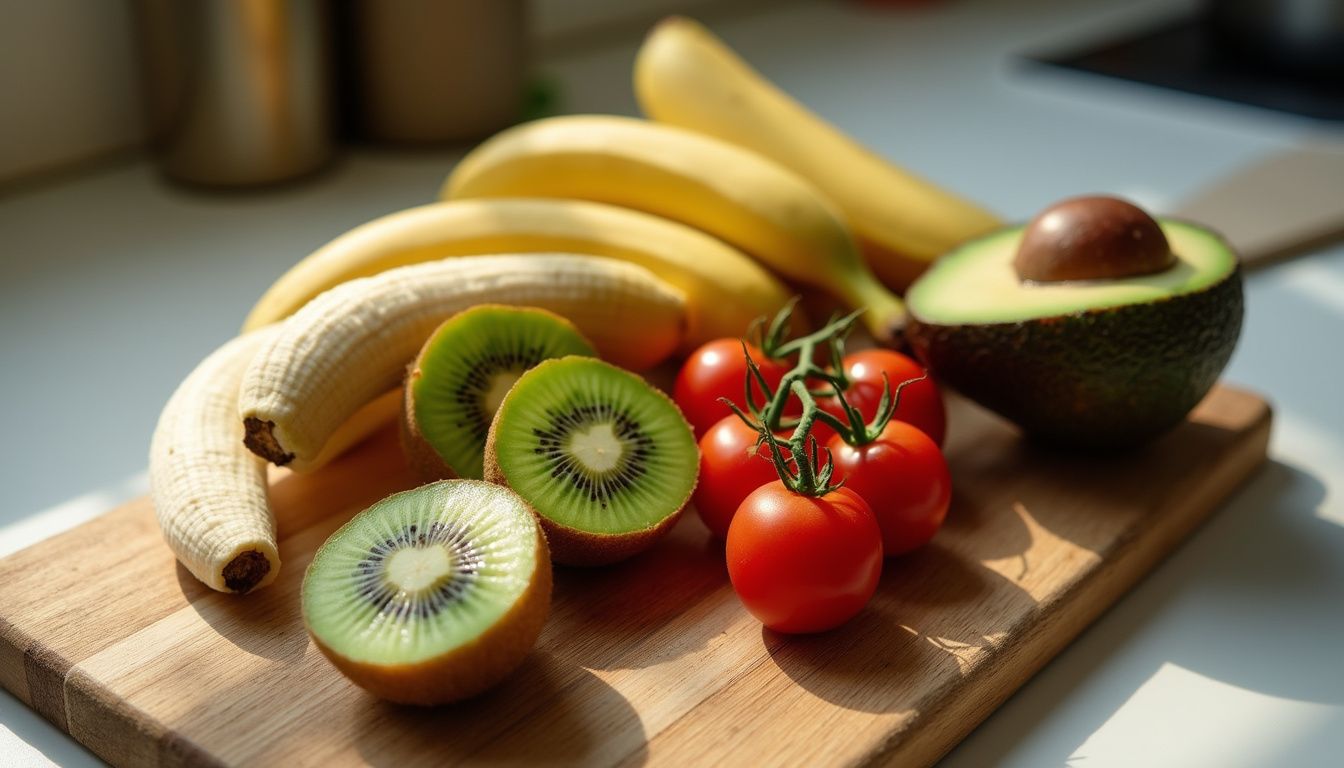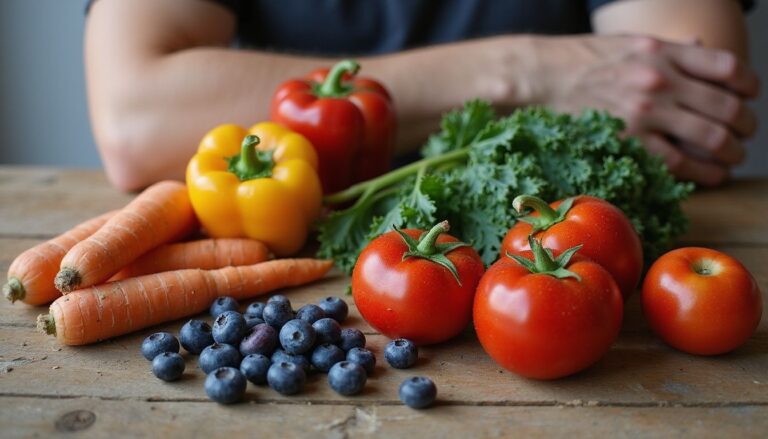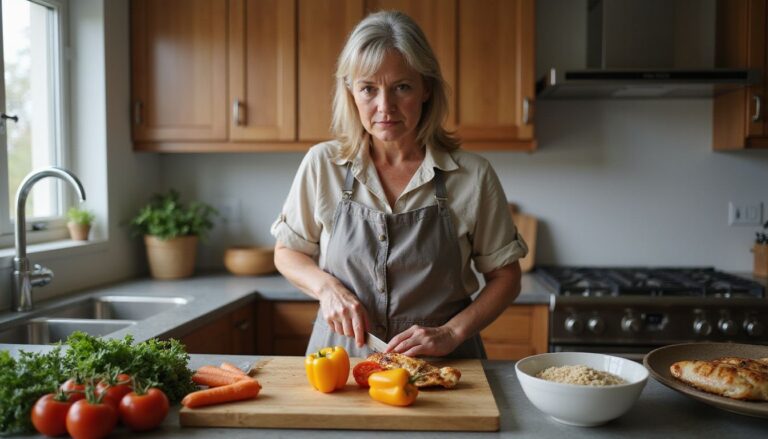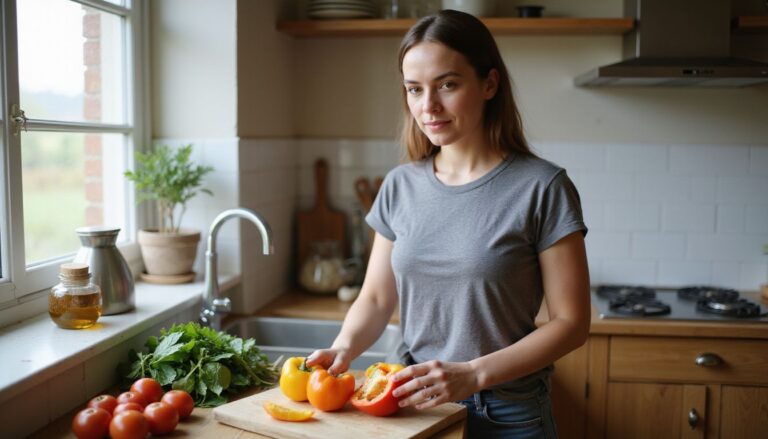Top Fruits High In Potassium: Boost Your Health With Potassium-Rich Foods
Our Nutrition Assistant AI Suite will transform your body. You will lose fat, get toned, and build muscle. Gain confidence and optimal health.
Many people fall short on potassium, and that can affect the heart and muscles. I struggled too until I realized that fruits high in potassium are simple, tasty ways to fill the gap. Potassium-rich foods are easy to find, and with a few small swaps, the benefits add up fast.
Strong research backs these ideas, including guidance from the Food and Drug Administration and the National Institutes of Health. In this guide, I share clear tips to spot top sources of potassium and how to use them in daily meals. See which fruit could help you feel better today.
Key Takeaways
- Most adults should aim for 4,700 mg of potassium per day to support heart, muscle, and nerve function.
- High potassium fruits include bananas, about 422 mg per medium banana, avocados, about 345 mg per half, watermelon, about 14% DV in two wedges, and dried apricots, about 1,000 mg per half cup.
- Potassium helps the body flush sodium, supports normal muscle contraction, and lowers the risk of irregular heartbeats.
- People with kidney disease must track potassium intake because high levels can cause hyperkalemia, a dangerous rise in blood potassium.
- Nutrition Facts labels use a 4,700 mg daily value for potassium, which aligns with FDA and USDA labeling rules.

Why Potassium is Essential for Health
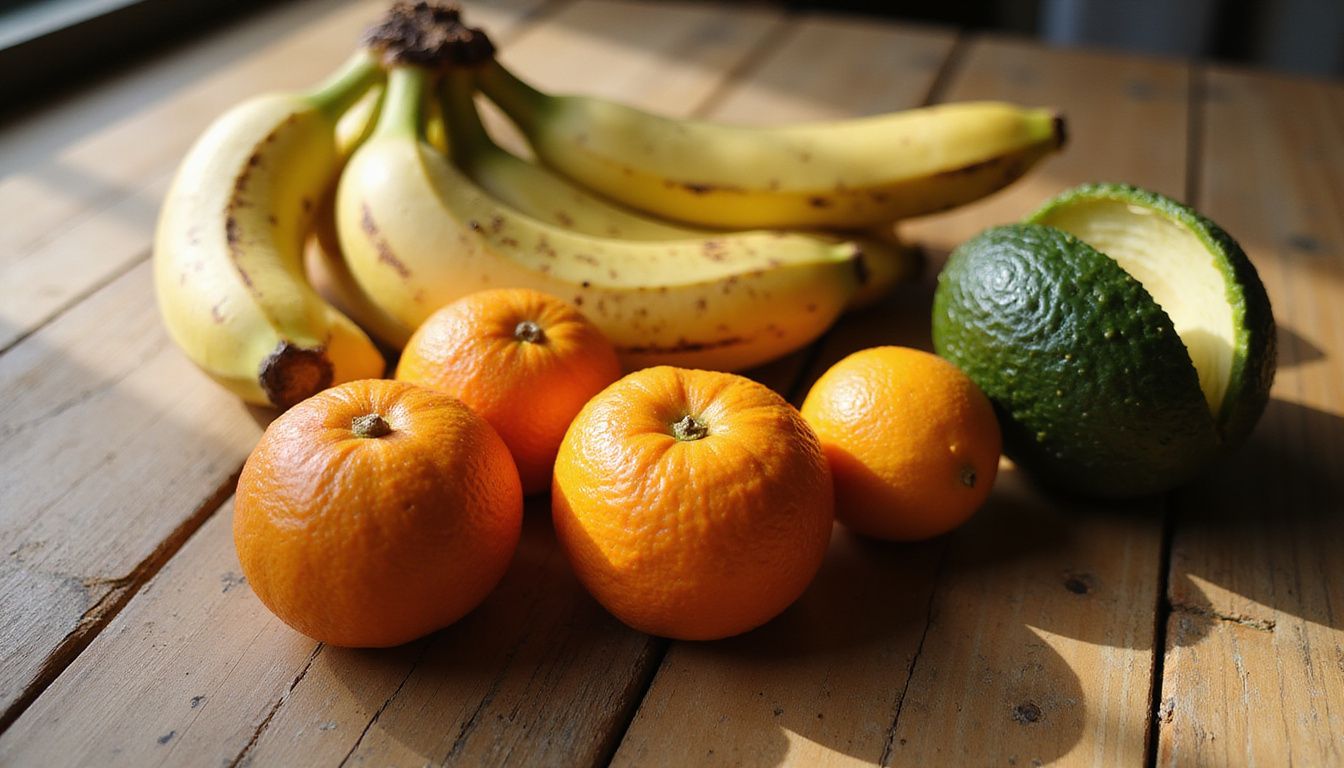
Potassium is a mineral and electrolyte. That means it carries tiny electrical charges that help cells work. I notice the difference when I eat potassium-rich foods. My blood pressure stays in a better range, and my muscles feel steady.
What role does potassium play in the body?
I rely on potassium to keep fluid levels balanced inside and outside my cells. This balance supports blood pressure, muscle movement, and heartbeat rhythm. Potassium also helps nerves send messages so muscles can contract and relax on cue.
Since the body does not make potassium, I get it from foods like bananas, avocados, pomegranates, and dried apricots. Potassium ferries nutrients into cells and moves waste out,
a clear summary often cited in medical nutrition texts. If I fall short, I may feel weak or notice cramps. In serious cases, low potassium can trigger irregular heart rhythms, known as arrhythmias.
How does potassium benefit the heart, muscles, and nerves?
Potassium supports the heart by helping blood vessels relax, which can lower blood pressure. It also helps the kidneys remove extra sodium in urine. I think of it as a daily reset for my cardiovascular system.
This mineral is key for muscle contraction, including the heart muscle. Eating high potassium foods like bananas, avocados, and dried apricots helps my muscles fire smoothly. Potassium also carries nerve signals that guide movement and reflexes. Balanced levels guard against abnormal rhythms and reduce cramps during long walks or workouts.
Knowing how much I need each day makes the next section on daily targets more useful.
Daily Potassium Requirements
I check my daily potassium requirement to stay on track. The FDA daily value, used on labels, is 4,700 milligrams for most adults.
What is the recommended potassium intake for adults and children?
Most Americans do not meet suggested potassium targets. That shortfall affects blood pressure control and muscle function. Here are common reference values used in the United States.
| Age Group | Recommended Daily Potassium Intake (mg) | Details |
|---|---|---|
| Adults (19+ years) | 4,700 | FDA daily value used on Nutrition Facts labels |
| Adolescents (14-18 years) | Varies (less than 4,700) | Needs increase with age but do not reach adult levels |
| Children (9-13 years) | Varies (lower than adults) | Requirements rise gradually during growth |
| Children (4-8 years) | Varies (less than older children) | Use age-specific guidance, avoid unsupervised supplements |
| Infants and Toddlers (1-3 years) | Varies (lowest needs) | Supplementation only if prescribed by a clinician |
- Adults need about 4,700 mg per day for best results.
- Children need less, and the amount changes with age.
- Labels use 4,700 mg as the reference daily value.
- Food first is best. Potassium supplements should be guided by a healthcare professional.
What factors affect how much potassium you need?
Age, sex, health conditions, and medicines change potassium needs. The Dietary Guidelines for Americans align with a range of about 2,600 to 3,400 mg for many adults, while the label daily value is 4,700 mg. Children and teens need less, and the amount increases with growth.
People with chronic kidney disease often need to limit potassium, because their kidneys do not clear extra potassium well. Highly active people may need more potassium because they lose it in sweat. Certain blood pressure or heart medicines can tilt levels up or down. A processed diet often brings more sodium and added sugar, and fewer natural sources of potassium.
Your daily routine, activity level, and health status shape how much potassium you should target.
Next, I break down the top fruits that make getting enough potassium much easier.
Top Fruits High in Potassium
I reach for fresh fruit to increase my potassium intake. These choices add flavor, fiber, and hydration without much effort.
Avocados
Half an avocado, about 68 grams, has roughly 345 mg of potassium, close to 7% DV. A whole avocado can approach 15% DV. Avocados are low in sodium and high in unsaturated fat, folate, and vitamin K.
I add avocado to toast or salads to raise potassium without raising salt. Research links avocado intake with better blood pressure numbers, which supports heart health.
Bananas
A medium banana provides about 422 mg of potassium, close to 7% DV. Bananas are an easy, portable choice that supports muscle and nerve function. They fit into breakfast bowls, smoothies, or a quick snack after a walk.
While some beans and dried fruits contain more potassium per serving, bananas are consistent, available, and affordable.
Watermelon
Two wedges of watermelon, about 572 grams, provide just under 14% DV for potassium. Watermelon also delivers water, magnesium, and vitamins A and C. I pack slices for hikes because they help with hydration while adding minerals.
This fruit pairs well with salty foods at picnics, as the potassium helps the body manage sodium balance.
Oranges
One medium orange gives around 200 mg of potassium. One cup of orange juice provides about 496 mg, roughly 10% DV. Oranges are low in sodium and rich in vitamin C.
I add orange segments to salads for a sweet lift, or drink a small glass of juice with breakfast. It is a simple way to move closer to my daily target.
Pomegranates
One whole pomegranate, about 282 grams, delivers about 14% DV for potassium. It also supplies folate, vitamin C, vitamin K, and fiber.
I sprinkle the arils over yogurt or salads. The bright seeds boost color and crunch while supporting heart and bone health.
Cantaloupe
One cup of diced cantaloupe contains about 420 mg of potassium, close to 9% DV. It is hydrating and sweet, which makes it a great snack or breakfast add-on.
I often combine cantaloupe with a pinch of lime and mint. It tastes refreshing and helps meet my daily potassium goal.
Dried apricots
Half a cup of dried apricots, about 65 grams, provides roughly 1,000 mg of potassium, about 21% DV. This fruit also brings fiber plus vitamins A and E for eye and skin health.
I keep a small container in my bag. A handful keeps my energy steady and my potassium level rising through the day.
Next, I list other foods, beyond fruit, that make it easier to meet daily needs.
Other High-Potassium Foods
You can get more potassium from a mix of foods and drinks, which makes reaching your goal much easier.
Sweet potatoes
One cup of baked sweet potato, around 200 grams, provides about 20% DV for potassium. Sweet potatoes also deliver beta carotene, which the body converts to vitamin A.
I roast them as a side or cube them into grain bowls. If you are on a low-potassium diet because of kidney disease, talk with your clinician about portion sizes.
Spinach
Three cups of raw spinach, about 90 grams, supply around 10.5% DV for potassium. Spinach is also rich in vitamins A and K, folate, and magnesium.
I toss spinach into soups, omelets, and salads. It is a quick way to raise potassium and support the circulatory system.
Tomatoes
One cup of raw tomatoes provides about 9% DV for potassium. Tomato paste and puree contain more per serving because they are concentrated. One fourth cup of paste has about 670 mg, and half a cup of puree has about 560 mg.
I use fresh tomatoes in salads and roasted sauces. Lycopene in tomatoes supports heart health, and the potassium supports muscles and nerves.
Coconut water
About 250 mL of unsweetened coconut water provides around 8.5% DV for potassium. It also contains small amounts of sodium and manganese, which support fluid balance.
I drink it after exercise to replace electrolytes lost in sweat. It is a light, low-calorie choice compared with many sports drinks.
Beans and legumes
Beans and legumes pack serious potassium. Per cooked cup, white beans provide about 21% DV, soybeans about 19%, black beans about 17%, and lentils about 15%. Chickpeas add about 10%, and one ounce of peanuts adds about 4%.
I rotate lentils, black beans, and soybeans in soups and salads. These foods also supply protein and fiber. They help nerves and muscles fire correctly, a process called the action potential.
Benefits of Potassium-Rich Fruits
High potassium fruits support the heart, muscles, nerves, and bones. Think of them as small daily deposits in your health bank.
How do potassium-rich fruits regulate blood pressure?
Potassium-rich foods help the kidneys flush extra sodium. That eases pressure on blood vessel walls and supports healthy readings. A banana, an avocado, or a bowl of cantaloupe can help move your numbers in the right direction.
Fruits with high potassium are almost always low in sodium, which makes the pairing even more helpful. Adults who approach 4,700 mg per day see the greatest effect in studies from public health agencies and medical journals.
How do they support muscle and nerve function?
Muscles need potassium to contract and relax. The mineral works with sodium to keep a steady acid base balance inside cells. When I eat enough potassium, my legs cramp less and recover faster after workouts.
Nerve cells use potassium to carry electrical signals. Those signals control movement, reflexes, and heartbeat. Low potassium can cause cramps, weakness, or fatigue. In severe cases, it can trigger abnormal rhythms. I noticed fewer cramps two weeks after I added more cantaloupe and watermelon to breakfast.
In what ways do they improve bone health?
Avocados, bananas, and dried apricots bring potassium that helps the body use calcium. Better calcium use supports bone density and lowers the risk of thinning bones, called osteoporosis. Many of these fruits also provide magnesium and vitamin K, both helpful for strong bones.
I increased my intake of oranges and cantaloupe after learning that potassium-rich diets may reduce kidney stones. Fewer stones mean less strain on the body, which supports bone health over time.
How do these fruits aid hydration and electrolyte balance?
Fruits such as watermelon and citrus provide water and potassium together. That mix supports fluid balance in cells and helps prevent fatigue. Bananas and dried apricots also replace potassium lost in sweat after activity.
On longer walks, I pack oranges or cantaloupe. They keep me hydrated and energized without heavy drinks.
Next, I share easy ways to use these fruits in daily meals and snacks.
How to Incorporate Potassium-Rich Fruits into Your Diet
I use simple habits to work more potassium into breakfast, lunch, snacks, and smoothies. Small steps, repeated often, get me to my daily goal.
What are some ways to add potassium-rich fruits to smoothies and salads?
Here are quick combinations I use a few times each week:
- Smoothies: blend banana, avocado, or cantaloupe with yogurt and a handful of spinach.
- Salads: add orange segments, watermelon cubes, or pomegranate seeds for color and crunch.
- Toppings: swap cheese or croutons for sliced avocado or chopped dried apricots.
Experts at the National Institutes of Health suggest most adults need around 2,600 to 3,400 mg of dietary potassium, depending on age and sex. These simple mixes help me close the gap without relying on fish or meat alone.
How can you use these fruits as healthy snacks?
Snack ideas that raise potassium fast:
- Dried apricots, half a cup, for about 1,000 mg of potassium.
- A medium banana after workouts for 422 mg and quick energy.
- Orange slices or a small cup of pomegranate arils over yogurt.
- Avocado on whole-grain toast with chia seeds for fiber and healthy fat.
- Watermelon chunks or cantaloupe balls in a chilled container.
These choices help me meet potassium needs while cutting back on salty, processed snacks that can raise blood pressure.
How to include potassium-rich fruits in breakfast meals?
I top oatmeal or whole-grain cereal with banana slices or diced cantaloupe. A half avocado on toast adds about 7% DV for potassium. One cup of orange juice offers about 496 mg, a solid start to the day.
Watermelon wedges pair well with eggs or yogurt for a hydrating breakfast. Using two or three of these options puts me closer to daily targets for both adults and children.
When to Monitor Potassium Intake
Some people need to track potassium closely, especially with kidney problems or certain medicines. Paying attention helps prevent both low and high levels.
Why should people with kidney disease monitor potassium?
With kidney disease, the kidneys do not remove extra potassium well. High potassium in the blood, called hyperkalemia, can trigger dangerous heart rhythms. For people on dialysis, even a few high potassium meals can push levels up quickly.
Your clinician may advise smaller portions of high potassium foods and caution with salt substitutes that contain potassium. Typical targets for healthy adults range from about 2,600 to 3,400 mg based on age and sex, but people with chronic kidney disease often need less. Symptoms like muscle weakness or irregular heartbeat need prompt medical care.
What are the signs of potassium deficiency or excess?
Too little or too much potassium can cause symptoms. Watch for these warning signs, especially if you eat a lot of high potassium foods like bananas, oranges, chard, sweet potato, or winter squash such as butternut squash.
- Muscle cramps and weakness may signal low potassium. I notice this after heavy exercise if I do not eat enough high potassium foods.
- Fatigue and low energy can occur when cells lack potassium for normal function.
- An irregular heartbeat can reflect either low or high potassium. Get checked quickly.
- Constipation can be an early symptom of low potassium and may appear with muscle twitching.
- Extreme thirst and low blood pressure point to serious deficiency. Lightheadedness can follow.
- Nausea, chest pain, shortness of breath, or muscle pain suggest high potassium. Seek urgent care.
- Paralysis is rare but possible in severe deficiency. Treat this as an emergency.
If you take blood pressure or heart medicines, ask your clinician how to monitor potassium safely.
Frequently Asked Questions
These quick answers help you choose foods high in potassium and use them well.
What are the best fruits for potassium?
Avocados provide about 7% DV per half fruit. Bananas offer about 422 mg per medium banana. Two wedges of watermelon supply nearly 14% DV. One medium orange gives about 200 mg, and one whole pomegranate provides about 14% DV.
Cantaloupe has about 420 mg per cup. Dried apricots lead for convenience, with about 1,000 mg in a half cup. I often add dried apricots or banana slices to oatmeal for a fast morning boost.
Can you get too much potassium from fruits?
Most healthy people will not get too much potassium from fruit alone. For example, a large banana has about 480 mg, which is only about 10% of the 4,700 mg daily value. Problems mainly occur when the kidneys cannot remove extra potassium.
If you have kidney disease, your clinician may limit high potassium foods and drinks. Avoid unsupervised potassium supplements because they can raise blood levels quickly. If you have concerns, ask for a blood test to check your potassium level.
How can I quickly increase my potassium levels?
I focus on food first. I eat bananas, avocados, sweet potatoes, white beans, and spinach. A glass of orange juice offers close to 500 mg. Pomegranate juice is another quick choice.
For snacks, I keep dried apricots on hand. For breakfast, I blend cantaloupe or watermelon into smoothies. If I get leg cramps after a workout, I add an extra serving of a high potassium food to my next meal.
Conclusion
Fruits high in potassium support the heart, muscles, and nerves while adding color to every plate. Choices like bananas, oranges, avocados, cantaloupe, and dried apricots make it easy to reach daily potassium goals. I notice better energy and steadier blood pressure when I keep these foods in rotation.
Pick food first before supplements, and talk with a clinician if you have kidney disease or take heart medicines. Small changes, such as a banana at breakfast or avocado on toast, can raise potassium intake in a simple, healthy way.
Health information here is educational in nature. For personal advice, including potassium supplements or a low-potassium diet, consult your healthcare professional or a registered dietitian.
FAQs
1. How much potassium do you need each day for good health?
Most adults need about 2,600 to 3,400 milligrams of potassium daily according to the National Institutes of Health. This amount helps maintain healthy cell function and supports heart and muscle activity.
2. Which fruits are high in potassium that can help meet my needs?
Bananas, oranges, cantaloupe, apricots, and prunes are top fruits high in potassium. For example, one medium orange (fruit) provides around 237 milligrams of potassium.
3. Can eating yams or other vegetables also boost my potassium intake?
Yes; yam (vegetable) is a strong source of dietary potassium along with potatoes and spinach. Including both fruits like oranges and vegetables such as yams ensures your cells receive enough minerals for proper function.
4. Why does the body’s cell biology depend on getting enough foods rich in potassium?
Potassium plays a key role in cell (biology). It helps balance fluids inside cells and supports nerve signals throughout the body. Eating plenty of foods high in this mineral keeps your muscles working well and protects overall health.
Summary: Potassium-rich foods such as bananas, oranges, yams, and leafy greens support vital functions at the cellular level while helping you reach recommended daily amounts for better health outcomes.

